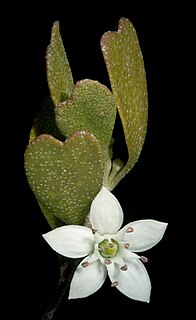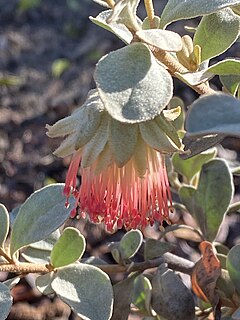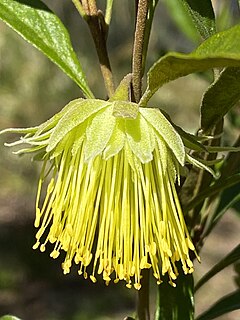
Phebalium whitei is a small shrub that is endemic to south-east Queensland. It has branchlets covered with silvery and rust-coloured scales, leathery, oblong to elliptic leaves and bright yellow flowers arranged in sessile umbels on the ends of branchlets.

Phebalium squamulosum , commonly known as scaly phebalium or forest phebalium, is a species of shrub or slender tree that is endemic to eastern Australia. It has smooth branches covered with rust-coloured scales, linear to elliptical or egg-shaped leaves with the narrower end towards the base, and pale to bright yellow flowers in umbels with rust-coloured or silvery scales on the back.

Leionema elatius, commonly known as tall phebalium, is a shrub species that is endemic to New South Wales and Queensland in Australia. It has glossy green, variably-shaped leaves and clusters of white-lemon flowers in spring.
Nematolepis frondosa, commonly known as leafy nematolepis, is a shrub that is endemic to Victoria, Australia. It is a small, conical shaped shrub with glossy leaves, scaly branchlets and white flowers in winter and spring.

Leionema carruthersii is a small shrub that is endemic to southern New South Wales in Australia. It has mostly greenish-yellow flowers, distinctive stamens and lance to egg-shaped leaves.

Leionema ellipticum is a shrub species that is endemic to Queensland in Australia. It is a small shrub with smooth green leaves and creamy-white flowers in spring.
Leionema hillebrandii, commonly known as Mount Lofty phebalium, is a perennial, woody shrub endemic to South Australia. It has variable shaped leaves and pinkish flowers from late winter to spring.
Phebalium drummondii is a species of small shrub that is endemic to Western Australia. It has smooth branchlets covered with silvery scales, broadly elliptic to egg-shaped leaves with silvery scales on the lower side and bright yellow flowers arranged in umbers on the ends of branchlets.
Leionema sympetalum, commonly known as Rylstone bell, is a shrub with greenish-yellow tubular flowers in small terminal clusters at the end of smooth, angular branches. It has a restricted distribution, grows near Rylstone in New South Wales.

Leionema viridiflorum commonly known as green phebalium, is a species of flowering plant in the family Rutaceae. It is a small shrub with pale yellow-greenish flowers in clusters at the end of branches from winter to early spring. It has a restricted distribution in northern New South Wales.

Rhadinothamnus rudis is a small shrub with needle-shaped, angular branchlets and single white flowers at the end of branches. This species and the three subspecies are endemic to Western Australia.

Rhadinothamnus euphemiae, is a slender, small, upright shrub with needle-shaped branchlets thickly covered with silvery scales and tubular greenish-purple tubular flowers throughout the year. It is endemic to the south coast of Western Australia.

Nematolepis phebalioides, is a small, spreading shrub with ascending branches covered in scales, smooth, glossy leaves and pendulous, red tubular flowers with yellow or green tips, flowering from March to December. It is endemic to Western Australia.

Diplolaena mollis, is a species of flowering plant in the family Rutaceae and is endemic to the west coast of Western Australia. It has broadly elliptic or egg-shaped, leathery leaves that are densely covered in hairs and reddish, pendulous flowers.
Diplolaena cinerea, is a species of flowering plant in the family Rutaceae and is endemic to the west coast of Western Australia. It has pale orange flowers, papery, elliptic shaped leaves that are covered in star-shaped hairs on the upper surface.

Diplolaena dampieri, commonly known as Dampier's rose,is a species of flowering plant in the family Rutaceae. It is endemic to the west coast of Western Australia. It has slightly leathery, oblong-elliptic shaped leaves, hairy bracts and pale red to orange flowers from July to September.
Diplolaena drummondii is an endemic Australian flowering plant in the family Rutaceae. It is only found in Western Australia. It is a small, spreading shrub with oblong to elliptic papery, thin leaves, and yellow, orange or reddish flowers which bloom between July and November.

Diplolaena microcephala is a rounded shrub with elliptic leaves, distinctive stamens, variable flower colour and is endemic to Western Australia.
Hibbertia graniticola is a species of flowering plant in the family Dilleniaceae and is endemic to the south-west of Western Australia. It is a shrub with thick, linear leaves and yellow flowers borne singly on the ends of branchlets, with seventeen to thirty stamens arranged around the two or three carpels.
Pomaderris graniticola is a species of flowering plant in the family Rhamnaceae and is endemic to eastern Australia. It is a shrub or small tree with hairy young stems, lance-shaped to elliptic leaves, and sparse panicles of yellow, white or cream-coloured flowers.












